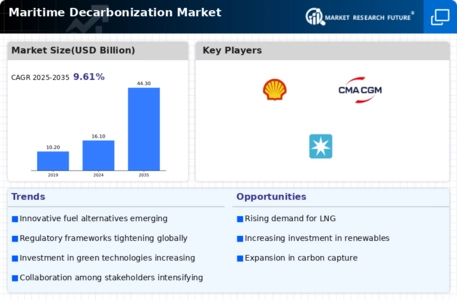The Maritime decarbonization Market is a dynamic and competitive industry encompassing various players offering a wide range of advanced and efficient Maritime decarbonization technology to meet the growing demand across numerous applications. This market is segmented by Maritime decarbonization fuel type, application, and region. Key drivers of market growth include The increasing adoption of energy efficiency measures, such as slow steaming and waste heat recovery, driven by their crucial role in enabling various technological advancements. Furthermore, the Maritime decarbonization Market is dominated by major players such as Shell, Wartsilla, CMA CGM Group, Maersk, and others.
These companies’ leaders have a strong global presence and offer an extensive array of Maritime decarbonization Industry. They compete on factors such as technological advancement, R&D, and innovation. These key players are actively involved in research and development activities to introduce new Maritime decarbonization technologies and expand their product portfolios through strategic initiatives like mergers, acquisitions, partnerships, and collaborations with other industry participants. The Maritime decarbonization Market has also felt the impact of the COVID-19 pandemic, leading to fluctuations in demand and supply chain disruptions.
However, as the global economy gradually recovers, the market is expected to rebound, driven by the growing reliance on Maritime decarbonizations in essential technologies. The market's future prospects are promising, with Maritime decarbonizations set to play a pivotal role in the ongoing technological transformations and innovations, making them an integral technology of the evolving global industrial landscape.
Shell: Shell plc (Shell), formerly Royal Dutch Shell Plc, is an integrated oil & gas company. The company explores and produces oil & gas from conventional fields and sources such as tight rock, shale & coal formations. It operates refining & petrochemical complexes across the world. Shell’s product offerings include lubricants, bitumen, and liquefied petroleum gas; and petrochemical products such as raw materials for plastics, coatings, and detergents. The company’s reporting segments are integrated gas, upstream, oil products, chemicals, and corporate. The company is a major producer of biofuel in Brazil.
It also has interests in various liquefied natural gas (LNG) and gas-to-liquids (GTL) projects. Moreover, the company has its operations in over 70 countries. The company markets its products directly and indirectly through distributors in Europe, Asia, Oceania, Africa, North America, and South America.
CMA CGM Group: CMA CGM Group is a French multinational transportation and logistics company headquartered in Marseille, France. It is the world's third-largest container shipping company by TEUs (twenty-foot equivalent units). CMA CGM Group operates a fleet of over 500 vessels and has a presence in over 160 countries. The company provides a wide range of shipping and logistics services, including container shipping, terminal operations, inland transportation, and logistics solutions.
In September 2023, CMA CGM and Maersk collaborated to accelerate the decarbonization of the shipping industry. This collaboration marks a significant turning point in the industry's decarbonization. The company will speed the development of innovative solutions and technology, helping our industry to meet its CO2 reduction targets, by merging the know-how and expertise of two leading figures in the maritime industry. The company is excited about new members joining them. Maersk seeks to expedite the green transition in logistics and shipping, and in order to do so, the company needs robust support from industry partners.
The company is happy to have CMA CGM as an ally, and this shows that when we work together via committed relationships and efforts, a real and promising route towards a sustainable future can be seen.














Leave a Comment